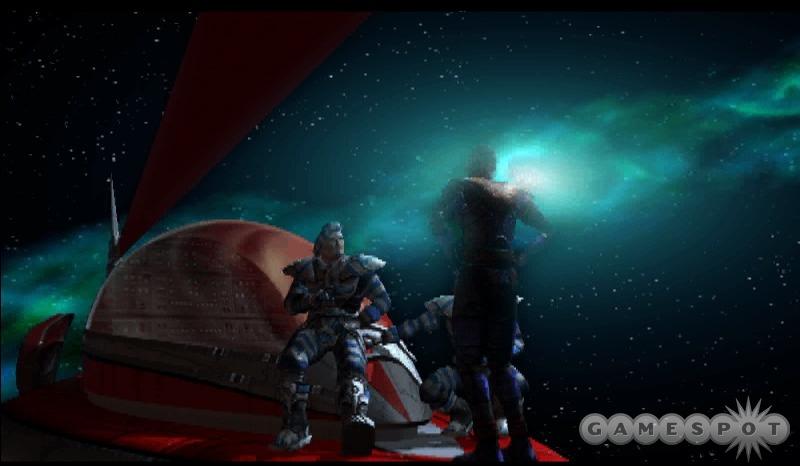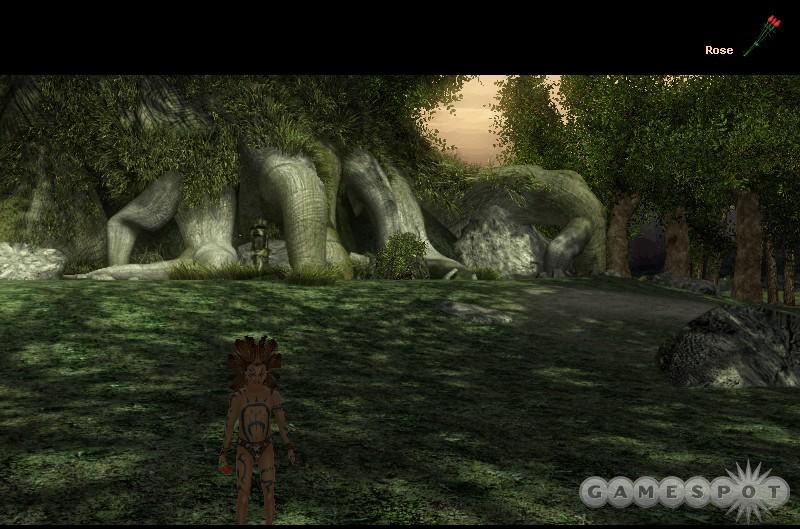Some games are so odd that they make you do a double take when you first hear about them, and they make you shake your head in disbelief when you're done playing them. That was certainly the case with 1999's Ring: The Legend of the Nibelungen. Here was an adventure game based on Richard Wagner's 15-hour opera cycle, Der Ring des Nibelungen. A retelling of Germanic and Norse myths, this cycle is one of the great monuments of Western art, filled with glorious music and rich symbolism. For some reason, the game's developer decided to turn it into a science fiction tale set in the 40th century AD. Other than featuring Wagner's music, the game was a dud. Along with its muddled concept, it hit you with a nonsensical story, incoherent puzzles, pixel hunts, surprise deaths, boring characters, and bland graphics. Despite scathing reviews far and wide, developer Arxel Tribe decided to create a sequel called Ring II: Twilight of Gods (or Twilight of the Gods, depending on whether you look at the game's box or its title screen). Early in the game, a futuristic dwarf scolds your character with such strong words as "Deplorable! Miserable! Abominable!" This applies equally to the game itself. The utterly atrocious, incomprehensible Ring II is an insult to both gaming and a great composer.

Things get off to an absolutely horrid start and never improve. First, you may notice that the game can shut down other programs you have running--unannounced. Once in the game, an intro scene shows a spaceship gliding into view. You soon see it's actually more like a sailing ship that just happens to be in outer space. A few crew members casually sit around on the open deck, as if breathing in an ice-cold vacuum were no problem at all. They start talking about some character--and it's unclear who--while standing on the prow of the vessel. Suddenly, this shipwreck of a scene ends, and the action (and we use this term loosely) begins.
Some games can be confusing at first, but Ring II makes a fine art of leaving the player utterly clueless--not at the start but throughout most of the game. One second, you're watching the spaceship, and then you're suddenly watching some ugly dwarflike creature in front of a forge. Oddly, next to the dwarf you see someone or something in a cagelike metal suit. Immediately you wonder: Where's this forge? Who's the dwarf? Why do they need old-fashioned forges in the far future?
It turns out that you're in control of this poor, imprisoned chap, and you need to help get the forge working. This means that you'll need to operate the bellows. First you'll need to get to them, which ordinarily wouldn't be much of a problem. The developer apparently forgot about the last 20 years of gaming history, though, and decided to forgo mouse-controlled movement. You'll have to use the keyboard to move your character--whoever he is. (And if you don't like the preset controls, tough luck. You can't change them without editing a .cfg file.) On top of that, your character moves at a glacial pace. With patience, you'll eventually reach the bellows. When you actually manipulate objects, you can finally use the mouse. That is, assuming it works, since your mouse movements and clicks don't always register well. Embarrassingly, the resulting animations are clunky. Meanwhile, the nasty dwarf is incessantly insulting you for your incompetence. Great.
After the grand excitement of moving the bellows up and down a bunch of times until it triggers a little scripted event is over, it's off to operate the forge's big hammer. Oops! A fire suddenly breaks out, and you have to figure out how to put it out. Normally, a little water would do the trick, but since it's hard to move, hard to interact with the environment, and hard to figure out what on earth is going on, it'll take a lot of work to get the job done. Too bad you couldn't just let the place burn down and be done with things.
If you press F1, you'll get a little relief as a menu opens. You'll see a button labeled "Story." Help at last! No such luck, it turns out. All you get is a few sentences roughly describing the backdrop of the game. At least if you happen to know Wagner's Ring cycle, you'll have understood that this opening sequence is a loose and utterly incompetent adaptation of part of the cycle's third opera, Siegfried. (Wagner would be spinning in his grave if he weren't so busy laughing at it all.) However, for those who are not in the know, the game will ensure that they remain this way.
The gameplay never improves, either. In fact, it's shockingly bad throughout. You'll have to pixel-hunt for objects, and you can only carry one item at a time (as apparently holding both a rose and a pair of pliers at the same time would exhaust our hero), so you'll have to run all over hill and dale to drop and pick up items repeatedly. Your character can disappear from view, and you can't move to some areas even though there's nothing blocking your path. Moreover, characters can actually get stuck on walls during cutscenes. The controls are clunky and aren't adequately explained in the two-page manual, so, for instance, there's no mention of the jump key. Action sequences hardly have any actual coherent action, and your character gets killed by nonsensical surprise attacks. Furthermore, bugs and typos mar the already disfigured gameplay.
Worst of all, you'll rarely have any clue as to what's going on. You'll have almost no idea who characters are, what their motivations are, what's happening to your character, or what puzzles are about. This is surely one of the most shamefully incomprehensible games ever made. It literally feels like it was written randomly, and only some knowledge of Wagner's work will help you "puzzle" the writing out.

Additionally, Ring II's presentation leaves tons to be desired. A few colorful backdrops can't compensate for dated graphics with laughable-looking characters, overly dark screens, and jerky animations, which all drag the game down further into its smelly pit. The sparse sound effects make no impression, and the actors repeatedly mispronounce names from the operas.
There's only one faint flicker of quality among the pervasive gloom: the occasional music. Richard Wagner (1813-1883) is spoken of in the same breath as Bach and Beethoven as one of the giants of Western music. His work is filled with sophisticated orchestration, innovative harmony, and unforgettable melodies and motifs--not to mention a masterful command of huge structures, as in the expansive Ring cycle. In Ring II, you'll hear various "bleeding chunks" of the Ring cycle. That is, you'll hear brief orchestral excerpts shorn from the vital vocal lines. Wagner purists might object to such an approach, but it's probably safe to say that not many Wagner purists will be playing this game. Either way, you'll get to enjoy some brilliant music, though its impact is nearly ruined in the context of such a stinky game.
You'd be better off buying a Ring highlights CD rather than playing this game. Or better yet, you could give the whole opera cycle a try. You'd be vastly better rewarded by doing this as an alternative to playing Ring II. Actually, you'd be better rewarded by doing anything at all versus playing this game. Deplorable, miserable, and abominable indeed.